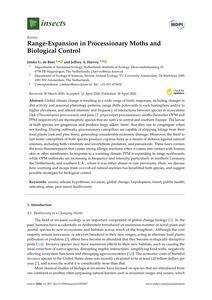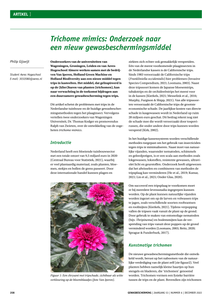Ghanaian farmers suffer from a decline in cocoa production partly due to damages and diseases from insect pests. To increase predation by bats on insects on the cocoa plantations we installed two different types of bat boxes on 15 plantations around the village of Buoyem. Bat activity, bat species composition (numbers of insectivorous and frugivorous bats) and insect abundance were measured before and after bat box installation. Insectivorous bats were present on all ofthe sampled plantations, namelyleaf-nosed bats (Hipposideros sp.), slit-faced bats (Nycteridae sp.), horseshoe bats (Rhinolophus sp.) and vesper bats (Vespertilionidae sp.). Furthermore, no correlation between insect abundance and bat activity could be detected. The bat boxes were not occupied yet during the research period since rainy season started in the second half of the measurements and bat activity decreases with increasing precipitation which is supported by our Un dings. Additionally, the available time period between in stallation and measuring of the effects of the boxes was very short when compared to similar researches. Bats alsohave different preferences per species for size and shape of bat boxes and the number of naturally available roosting sites also influences bat box occupancy. Our results suggest that bats are abundant above cocoa plantations in Buoyem and therefore bat boxes have the potential to be ahelpful tool in insect pest control.
DOCUMENT

Agriculture and horticulture are essential for ensuring safe food to the growing global population, but they also contribute significantly to climate change and biodiversity loss due to the extensive use of chemicals. Integrated pest management is currently employed to monitor and control pest populations, but it relies on labor-intensive methods with low accuracy. Automating crop monitoring using aerial robotics, such as flapping-wing drones, presents a viable solution. This study explores the application of deep learning algorithms, You Only Look Once (YOLO) and Faster region-based convolutional neural network regions with convolutional neural networks (R-CNN), for pest and disease detection in greenhouse environments. The research involved collecting and annotating a diverse dataset of images and videos of common pests and diseases affecting tomatoes, bell peppers, and cucumbers cultivated in Dutch greenhouses. Data augmentation and image resizing techniques were applied to enhance the dataset. The study compared the performance of YOLO and Faster R-CNN, with YOLO demonstrating superior performance. Testing on data acquired by flapping-wing drones showed that YOLO could detect powdery mildew with accuracy ranging from 0.29 to 0.61 despite the shaking movement induced by the actuation system of the drone’s flapping wings.
DOCUMENT
Insect hyperparasitoids are fourth trophic level organisms that commonly occur in terrestrial food webs, yet they are relatively understudied. These top-carnivores can disrupt biological pest control by suppressing the populations of their parasitoid hosts, leading to pest outbreaks, especially in confined environments such as greenhouses where augmentative biological control is used. There is no effective eco-friendly strategy that can be used to control hyperparasitoids. Recent advances in the chemical ecology of hyperparasitoid foraging behavior have opened opportunities for manipulating these top-carnivores in such a way that biological pest control becomes more efficient. We propose various infochemical-based strategies to manage hyperparasitoids. We suggest that a push-pull strategy could be a promising approach to ‘push’ hyperparasitoids away from their parasitoid hosts and ‘pull’ them into traps. Additionally, we discuss how infochemicals can be used to develop innovative tools improving biological pest control (i) to restrict accessibility of resources (e.g. sugars and alternative hosts) to primary parasitoid only or (ii) to monitor hyperparasitoid presence in the crop for early detection. We also identify important missing information in order to control hyperparasitoids and outline what research is needed to reach this goal. Testing the efficacy of synthetic infochemicals in confined environments is a crucial step towards the implementation of chemical ecology-based approaches targeting hyperparasitoids.
LINK
Control methods are applied worldwide to reduce predation on livestock by European red foxes (Vulpes vulpes). Lethal methods can inflict suffering; however, moral debate about their use is lacking. Non-lethal methods can also inflict suffering and can unintentionally lead to death, and yet both the welfare consequences and ethical perspectives regarding their use are rarely discussed. The aim of this study was to investigate the animal welfare consequences, the level of humaneness, the ethical considerations and the moral implications of the global use of fox control methods according to Tom Regan’s animal rights view and Peter Singer’s utilitarian view. According to Regan, foxes ought not to be controlled by either lethal or potentially harmful non-lethal methods because this violates the right of foxes not to be harmed or killed. According to Singer, if an action maximises happiness or the satisfaction of preferences over unhappiness or suffering, then the action is justified. Therefore, if and only if the use of fox control methods can prevent suffering and death in livestock in a manner that outweighs comparable suffering and death in foxes is one morally obligated t
MULTIFILE

Global climate change is resulting in a wide range of biotic responses, including changes in diel activity and seasonal phenology patterns, range shifts polewards in each hemisphere and/or to higher elevations, and altered intensity and frequency of interactions between species in ecosystems.Oak (Thaumetopoea processionea) and pine (T. pityocampa) processionary moths (hereafter OPM and PPM, respectively) are thermophilic species that are native to central and southern Europe. The larvae of both species are gregarious and produce large silken ‘nests’ that they use to congregate when not feeding. During outbreaks, processionary caterpillars are capable of stripping foliage from theirfood plants (oak and pine trees), generating considerable economic damage. Moreover, the third to last instar caterpillars of both species produce copious hairs as a means of defence against naturalenemies, including both vertebrate and invertebrate predators, and parasitoids. These hairs contain the toxin thaumetopoein that causes strong allergic reactions when it comes into contact with humanskin or other membranes. In response to a warming climate, PPM is expanding its range northwards, while OPM outbreaks are increasing in frequency and intensity, particularly in northern Germany,the Netherlands, and southern U.K., where it was either absent or rare previously. Here, we discuss how warming and escape from co-evolved natural enemies has benefitted both species, and suggest possible strategies for biological control.
DOCUMENT

Arthropod pests cause signifcant problems in agricultural crops all around the world. As chemical pesticide use becomes less desired, there is a need for alternative methods of pest control. Inspired by the natural adhesiveness of arthropod trapping plants, we examined the efectiveness of adhesive droplets made from oxidised and cross-linked plant-derived oils for control of western fower thrips.Key message:-Adhesive oil-based droplets can catch thrips and reduce their reproduction, survival and damage.-Among diferently sized droplets (up to>10 mm2), larger droplets trap relatively more thrips.-Droplets remain present after rinsing with water suggesting potential for in- and outdoor use.Keywords: duurzame gewasbescherming, biomimicry, insecten, trips, trichomen
LINK
Onderzoekers van de universiteiten van Wageningen, Groningen, Leiden en van Aeres Hogeschool Almere werken samen met de bedrijven Van Iperen, Holland Green Machine en Holland Biodiversity aan een nieuw middel tegen trips in kasteelten. Het middel, dat geïnspireerd is op de (klier)haren van planten (trichomen), kan naar verwachting in de toekomst bijdragen aan een duurzamere gewasbescherming tegen trips.
DOCUMENT

De aanwezigheid van ongewenste geleedpotigen in de meelwormenkweek brengt interessante uitdagingen met zich mee. Omdat bestrijding met insecticiden niet mogelijk is en de kweekomstandigheden die geschikt zijn voor de meelwormen ook geschikt zijn voor schadelijke dieren zoals meelmijten en spekkevers, moet er gezocht worden naar alternatieve manieren voor monitoring en bestrijding. Studenten van HAS hogeschool die aan de verschillende projecten hebben gewerkt, hebben verschillende methoden bedacht en uitgetest waarmee meelmijten bestreden en spekkevers gemonitord kunnen worden. Daarnaast hebben ze de relevantie hiervan ook aangetoond door aan te geven hoe schadelijk deze plaagsoorten voor een insectenkweek zijn. Hopelijk kunnen ze de schade, monitoringen bestrijding van meelmotten in de toekomst ook onderzoeken.
DOCUMENT

1e alinea column: Organisaties bestaan in feite omdat ze goedkoper dan de markt samenwerking organiseren. Dit eenvoudige gegeven ligt onder vrijwel alle analyses van de impact van Internet: Internet verlaagt de externe markttransactiekosten. Interne coördinatiekosten van de organisatie moeten dus naar beneden op straffe van verdampen van de organisatie. Dat dat proces in volle gang is getuigen de vele kostenbesparingsprogramma's en reorganisaties bij (grote) ondernemingen. Die zullen ook niet meer ophouden, voorspel ik je en uiteindelijk zullen de meeste corporates hele andere organisatieatie vormen krijgen, gebaseerd op P2P crowdsouring en zelfsturing. Hier trend 1 van 6.
LINK